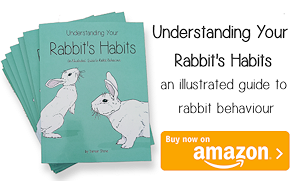Monitoring Your Rabbit's Droppings
A rabbit's digestive system is very efficient when it comes to processing their natural diet but it is also very sensitive and is easily be upset by the wrong types or proportions of foods. A good way to monitor how well your rabbit's digestive system is functioning, and therefore how successful the diet is, is to monitor the by-product of digestion... your rabbit's droppings. A change in droppings is often the first indication of digestive disruption.
Rabbits produce two types of droppings. Hard round pellets (faecal pellets) that contain the waste indigestible fibre and soft dark coloured droppings (cecotropes), which they re-ingest to obtain extra nutrients.
Faecal Droppings
Normal faecal droppings are round balls, dark to light brown in colour, and fairly inform in size. They are slightly moist when fresh but dry out quickly. If you examine them closely, or break one apart (they should crumble relatively easily), you will see the tiny rectangles of undigested plant fibre that they are formed from.

Droppings that are small, very dark in colour, or irregularly shaped are a signal that your rabbit is not processing enough fibre through his digestive tract. This may be because the diet is too low in fibre or because another problem has slowed down the travel of food through the digestive system.
If your rabbit stops producing any droppings, the gut may have completely stopped processing food; this should be treated as a potentially life threatening emergency and you should seek urgent veterinary attention.
Cecotropes
Cecotropes are a group of soft squishy pellets that are stuck together in a way that resembles a blackberry. They are dark brown, almost black, in colour and a coating of mucus gives them a glossy appearance.

Rabbits usually produce cecotropes at the same time each day, often at night hence they are sometimes called "night droppings", but in pet rabbits, it is dependent on their daily routine and feeding times. The rabbit eats them straight from the anus so in a normal situation you will not see them. The only clue that your rabbit is producing them is seeing your rabbit duck its head down under its body and then sit up chewing.
A diet too high in carbohydrates, protein, or sugar can upset the balance of bacteria in the caecum causing the production of too many cecotropes. The rabbit ignores these extra dropping as they contain unneeded nutrients and they become stuck in the fur or squished on the floor instead.

This is most commonly a result of too much dry food or too many processed treats. In which case, you can resolve it by reducing the amount of pellets and increasing the amount of hay or feeding higher fibre/lower protein pellets (View Food Comparison Chart).
Learn about the components of a balenced diet
Several conditions can cause a physical impediment to eating cecotropes, including arthritis, an injury, or obesity. These all make it difficult for your rabbit to bend correctly to collect them and they will generally ignore them if they fall to the floor. Dental problems and illness can also affect rabbit's desire or ability to eat the cecotropes.
Diarrhoea
Diarrhoea (watery stool) is most common in baby rabbits (under 12 weeks). It can be caused by parasites or infection, as well as diet. It is a serious condition and requires immediate veterinary attention.















